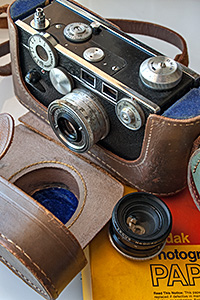Photo Corners headlinesarchivemikepasini.com
![]()
A S C R A P B O O K O F S O L U T I O N S F O R T H E P H O T O G R A P H E R
![]()
Reviews of photography products that enhance the enjoyment of taking pictures. Published frequently but irregularly.
Getting Started In Photography


8 April 2013
Over the weekend a nice thing happened at The Online Photographer when Mike Johnston asked his readers for a little advice. "Here's the question: young photographer (~20), in college, wants/needs dSLR," he began, ending, "Anyone have thoughts or advice for him?"
By this morning, the young lad had his pick of several donated setups. That was the nice thing.
GETTING STARTED
But here's the curious thing. How did you get started?
We've been meaning to transport ourselves to the Jenkins Johnson Gallery where there are still a few Gordon Parks photos on the wall until April 27. So every day we remind ourselves. And when the TOP story was published, we naturally thought of how Parks got his start.

Oour Argus C3. Battle weary from teaching us the ropes.
He picked up a Voightlander Brilliant for $12.50 in a pawn shop when the train he was working on as a waiter stopped in Seattle.
It didn't take long, you can bet, to remember our own start either.
We knew we needed a 35mm camera and we also knew we couldn't afford one. So we hit the flea market. We found an Argus C3 with two lenses (50mm and 35mm) and a nice leather case for $10. That's also where we found a nice Durst 606 enlarger for $50.
Accidents, really.
IN PHOTOGRAPHY
But very instructive ones. We only really needed something that spooled 35mm film. And we ran everything through that little box from Plus-X to Tri-X in black and white and from Kodak Gold to Kodachrome in color.
We swapped the 50mm out for the 35mm when we shot interiors or landscapes. And just before one particular real-estate assignment (yeah, we made our money back), we even dissembled the 35mm lens to clean the elements.
Rather than mastering the Argus (which, frankly, didn't take long), we were learning photography.
Color film wasn't cheap, but we could spool our own black and white with a bulk loader. And process the stuff in our bathroom at night. We'd make a contact print proof sheet to see if anything was worth working on and then print an enlargement, one precious sheet of paper after another.
When the sun came up again, we'd reload the Argus and see what the light of day brought forth, learning how to expose without a meter and then mastering a Kalimar meter we'd acquired with S&H Green Stamps.
Which is how one learned the ropes in those days.
MAKING ... MISTAKES
The gear wasn't the thing. In fact, the worse it was, the more you were liable to learn. And the more mistakes you made -- in exposure or technique -- the faster you learned.
Somehow even the junkiest flea market stuff managed to deliver the goods. A good image was still a good image. And because it was made on the same film the Nikon and Canon guys bought and printed on the same paper, it didn't yield a flea market product once you learned how to shoot.
The gear wasn't the hurdle it is today.
FAST FORWARD
Today the problem of getting started is a little different.
Cameras aren't inexpensive, even used. They're sophisticated electronic devices, with a sensor that circumscribes its photographic possibilities. And there are a lot more camera models, too.
But at the flea market? Ever see, say, a Nikon D40 with two lenses for $10 there? Or a Canon XTi?
No, today you hit eBay. But you have to know what you're looking for. So you need a recommendation. Which, really, skips a few lessons in the learning-through-failure method. Fate doesn't step in to see you through. You, uh, place your bid and cross your fingers.
And if you've got $200, you can start with that D40 or XTi.
There will still be lots to learn. And if you focus on the photography rather than the menu system, it will serve you a lifetime. Whatever you start out with.